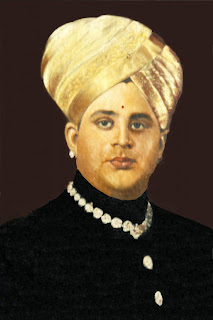Home to countless turbans (headgears), each region across India has its traditional headgear highlighting the culture and traditions of that region. The Indian rulers of Princely states of India took pride in appearing on certain important occasions with full royal regalia that would include their bejeweled attractive turbans. Their descendants, though lost the princely status post independence, still retain the long held tradition. This post is about the traditional Mysori Turbans of Karnataka state, South India
 |
| Mysore head gear. postagestamps.gov.in/ |
 |
| Maharajah of Mysore Jayachamaraja Wodiyar.Wikipedia |
Among the head-gears of South India, the traditional headgear worn in the state of Karnataka, particularly, in the Mysore and Kodgu regions is called Mysori Turban, Of late, considered as a heritage symbol, Mysori Peta is a popular one. Distinguished guests who visit these places are honored with it and a shawl. The name Mysore is synonymous with Indian sweet item called Mysore Pak, Mysore peta (Topi), Mysore silk (saris) and Mysore sandlewood paste (perfume). Mysore rasam is part and parcel of south Indian meal(lunch)..
 |
| Mysore Maharahah and his staff, KA starofmysore.com |
Above image: Maharajah KRW and Yuvarajah KNRW are seen with the Palace staff in this undated photograph. Almost all classes of officers sport a Mysore turban and sash. Collection: Ramsons Kala Pratishtana, photo credit: starofmysore.com.................
The Mysuru peta (in Kannada Peta means turban) is a prestigious formal turban, originally worn by the Kings of Mysore. Crafted from a long strip of luxurious silk or cotton cloth, it is elegantly wound around the head and often adorned with gold or silver lace borders and ornamental metal pendants. Since India's independence in 1947, the Mysuru peta has evolved into a symbol of the region's rich cultural heritage. It is now worn during formal occasions and bestowed upon distinguished individuals as a mark of honor, frequently accompanied by a shawl.
 |
| Bharat Ratna Dewan Vishveshwaraiah en.wikipedia.org |
Historically, the Wadiyar dynasty rulers wore richly jeweled turbans made of silk and gold-threaded lace, or jari, to complement their vibrant royal attire. Kings donned the traditional Mysuru peta during royal court meetings, public events like the Dassara religious festival, and parades held for visiting dignitaries. This ornate turban was also a part of the official attire for the King’s senior officials, including the Prime Minister (dewan).
Attendees of the royal court were expected to wear the Mysuru peta along with a long black coat and white trousers. Notable figures such as Bharat Ratna Dewan M. Vishveshwaraiah, Dewan of Mysuru like Ragnacharlu, Seshadri Aiyar, et al and a host of others such as chief engineers, judicial officers and others were often seen wearing this traditional headgear, signifying their high status and close association with the royal family.
The Mysore turban, or Mysore peta, has a documented history dating back to 1799 when five-year-old HH Krishnaraja Wadiyar III (KRW III) ascended the throne. Early stone carvings at the Trineshwara Temple show Wadiyar kings with hair tied in a side bun called "turubu." However, portraits from the Chitramantapa – Subbarayadasa Temple, painted during KRW III's reign, depict them wearing Mysore turbans.
 |
| Mysori turban earliest periodn starofmysore.com |
Above image: Raja Wadiyar. Vamsha Vruksha. Portrait Extract. Courtesy: Karnataka Chitrakala Parishath, Bangalore......
..
 |
| Mysore yuvarajah CEW in regal attire. wikipedia |
Above image: Yuvarajah CRW(Chama Raja Wadiyar) of Mysore kingdom, S. India in regal attire. 1877. Source: Wikipedia...............
An oil painting by Thomas Hickey, displayed at Rashtrapati Bhavan, shows the young KRW III in a circular turban. This style is also seen in a painting of Tipu Sultan's sons being handed to East India Company officials. Distinctive Mysore turbans appeared in official portraits of KRW III from the 1820s onwards. The Mysore atelier's artists have documented the evolution of the Mysore turban into its modern form through their portraits
In contemporary times, the Mysuru peta remains a popular choice for formal attire at weddings, religious gatherings, and award ceremonies, particularly in Mysuru and Kodagu. It is also embraced by academic institutions in Karnataka, where students and faculty are encouraged to wear the Mysuru peta during convocation ceremonies instead of the colonial-era mortarboard. This shift underscores a renewed appreciation for indigenous traditions and the importance of preserving cultural identity. The Mysuru peta continues to be a powerful symbol of regional pride and heritage, reflecting the enduring legacy of the Mysore Kingdom.









